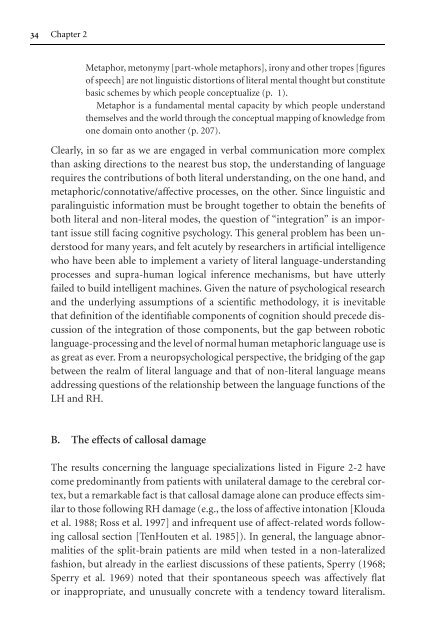Tone of Voice and Mind : The Connections between Intonation ...
Tone of Voice and Mind : The Connections between Intonation ...
Tone of Voice and Mind : The Connections between Intonation ...
Create successful ePaper yourself
Turn your PDF publications into a flip-book with our unique Google optimized e-Paper software.
34 Chapter 2<br />
Metaphor, metonymy [part-whole metaphors], irony <strong>and</strong> other tropes [figures<br />
<strong>of</strong> speech] are not linguistic distortions <strong>of</strong> literal mental thought but constitute<br />
basic schemes by which people conceptualize (p. 1).<br />
Metaphor is a fundamental mental capacity by which people underst<strong>and</strong><br />
themselves <strong>and</strong> the world through the conceptual mapping <strong>of</strong> knowledge from<br />
one domain onto another (p. 207).<br />
Clearly, in so far as we are engaged in verbal communication more complex<br />
than asking directions to the nearest bus stop, the underst<strong>and</strong>ing <strong>of</strong> language<br />
requires the contributions <strong>of</strong> both literal underst<strong>and</strong>ing, on the one h<strong>and</strong>, <strong>and</strong><br />
metaphoric/connotative/affective processes, on the other. Since linguistic <strong>and</strong><br />
paralinguistic information must be brought together to obtain the benefits <strong>of</strong><br />
both literal <strong>and</strong> non-literal modes, the question <strong>of</strong> “integration” is an important<br />
issue still facing cognitive psychology. This general problem has been understood<br />
for many years, <strong>and</strong> felt acutely by researchers in artificial intelligence<br />
who have been able to implement a variety <strong>of</strong> literal language-underst<strong>and</strong>ing<br />
processes <strong>and</strong> supra-human logical inference mechanisms, but have utterly<br />
failed to build intelligent machines. Given the nature <strong>of</strong> psychological research<br />
<strong>and</strong> the underlying assumptions <strong>of</strong> a scientific methodology,itisinevitable<br />
that definition <strong>of</strong> the identifiable components <strong>of</strong> cognition should precede discussion<br />
<strong>of</strong> the integration <strong>of</strong> those components, but the gap <strong>between</strong> robotic<br />
language-processing <strong>and</strong> the level <strong>of</strong> normal human metaphoric language use is<br />
as great as ever. From a neuropsychological perspective, the bridging <strong>of</strong> the gap<br />
<strong>between</strong> the realm <strong>of</strong> literal language <strong>and</strong> that <strong>of</strong> non-literal language means<br />
addressing questions <strong>of</strong> the relationship <strong>between</strong> the language functions <strong>of</strong> the<br />
LH <strong>and</strong> RH.<br />
B. <strong>The</strong> effects <strong>of</strong> callosal damage<br />
<strong>The</strong> results concerning the language specializations listed in Figure 2-2 have<br />
come predominantly from patients with unilateral damage to the cerebral cortex,<br />
but a remarkable fact is that callosal damage alone can produce effects similar<br />
to those following RH damage (e.g., the loss <strong>of</strong> affective intonation [Klouda<br />
et al. 1988; Ross et al. 1997] <strong>and</strong> infrequent use <strong>of</strong> affect-related words following<br />
callosal section [TenHouten et al. 1985]). In general, the language abnormalities<br />
<strong>of</strong> the split-brain patients are mild when tested in a non-lateralized<br />
fashion, but already in the earliest discussions <strong>of</strong> these patients, Sperry (1968;<br />
Sperry et al. 1969) noted that their spontaneous speech was affectively flat<br />
or inappropriate, <strong>and</strong> unusually concrete with a tendency toward literalism.


